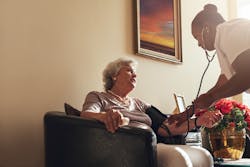A leader in home-based care innovation, Iowa-based UnityPoint Health has pulled together a group of home-based services under the UnityPoint at Home umbrella.
Speaking at the fall NAACOS conference last week, Mag VanOosten, R.N., president and chief clinical officer of UnityPoint at Home, described how they combined their comprehensive in-home care offerings.
“The secret sauce has been being able to pull our at-home services together under UnityPoint at Home,” VanOosten said. Their comprehensive in-home care includes home health, hospice, infusion therapy, rehabilitation, and home medical equipment (HME) services.
In fall 2020, the UnityPoint at Home Acute Hospital Care at Home program was one of six national health systems approved for the CMS Acute Hospital Care at Home demonstration. In February 2021 UnityPoint at Home was the first in the nation to admit and bill for patients.
“We started in 2016 with a proof of concept with just our NextGen ACO patients, saying we can do an expedited discharge, take the patients home, keep them home safely, have better outcomes, save the hospitals money and not take anything away from them because they were getting the full DRG [diagnosis-related group payment],” she explained. “We did that for a full quarter and then took the data that we collected and built our business plan. When you're in a hospital-based system trying to take patients out of the hospital, it took about a year to get everyone convinced. Our aim was to develop a proactive ambulatory-based alternate care solution. We wanted to reduce the patient's need to go into the emergency room, into the hospital, and into the skilled nursing facilities.”
VanOosten said they were looking at the moderate to high-risk, high-utilization population.
“We knew we could prove that we could deliver that quality experience and provide the economic outcomes through our innovative suite of services,” she added. “We built a proactive and preventative urgent interventional, serious illness management post-acute rehab and recovery program. We stood it up as a ‘care at home’ clinic. That's important because under home care, we couldn't bill for any of the provider-level visits. We've created a bricks-and-mortar clinic, where our provider actually bills out of and we combined it with the services that we could provide through UnityPoint at Home.” First the stood up Primary Care at Home, in which providers respond to either the patient's primary care provider or an urgent care that was slammed or an emergency room that asks them to go out and make a visit.
“We set that up with a four-hour response time and our provider could determine whether the patient actually needed to go into the hospital, whether we could refer home health and keep them at home safely, whether they needed to go to hospice or whether we needed to admit them into a hospital-to-home episode,” VanOosten explained.
With the Palliative Care at Home program, the goal is to keep the patient at home during the end of their life, whether that's in the last six months or the last 18 months, VanOosten said. “We want to be able to reduce the number of times that they go into the hospital.”
UnityPoint developed ambulatory care bundles around several of these models. “We felt that if we put 30 days of wraparound care with that patient, left the remote patient monitoring in place for 30 days, even though their acute episode was maybe three to five, we could determine when the patient was at risk to fail and cover that area,” VanOosten said.
UnityPoint recently partnered with a company called WellSky on its SNF at Home program to help patients with activities of daily living through centralized coordination with in-home clinical care, home medical equipment, and telehealth.
In a written statement discussing that partnership, VanOosten explained that “with SNF-at-home, patient-focused coordination among providers is vitally important and can be among the most challenging aspects of the care-at-home model. This partnership allows us to apply best practices with personal care partners using common WellSky platforms, enabling the coordination, coverage, and transitions that SNF-at-home requires.”
Together, UnityPoint at Home and WellSky say they are laying a foundation for alternative at-risk payment models designed to provide elevated levels of care in the home, relieving pressure on overloaded hospitals. UnityPoint at Home can fill the caregiver gap, allowing patients that are eligible for skilled care, and who require additional personal care support, to recover at home.
“We took our first official CMS waiver patient home under acute Hospital at Home on February 1, feeling like that was quite an accomplishment,” VanOosten said. “What we've proven with both the CMS waiver and our ambulatory waiver is that we can be sustainable deploying those ambulatory models of care. As we roll it out into our regions and as we stand up things like Palliative Care at Home and SNF at Home, what we realize is we really need to optimize evidence-based practices and best-known practices, and we've partnered with our ACO provider clinics, so that everyone understands what's happening with a patient.”
She said they have seen considerable ED and hospitalization reductions and 99.18 percent patient satisfaction for the patients that have gone through the hospital to home program. “This is pretty exciting stuff,” VanOsteen said. “The advice that I would have for our ACO partners is really start out with that comprehensive suite of services. It's the best way to create capacity; it's the best way to generate revenue with those provider-level visits; it's the best way to control and to see what's going on in the patient’s home. I'm a big fan of the ambulatory bundles and not just because I have all of the things that go with it, but because it's the right thing to do for the patient. It keeps an eye on the patient for that full 30 days that they're at risk. Where they really want to be is at home, so let's help keep them home.”


